Piston, Connecting Rod, and Bearing Installation
Special Tools
| • | EN 8037 Ring Compressor |
| • | EN 43690-A Rod Bearing Clearance Checking Tool |
| • | EN 46121 Connecting Rod Guide Pin Set |
| • | EN 48589 Crankshaft Rotation Socket |
For equivalent regional tools, refer to Special Tools .
Piston and Connecting Rod Assembly Procedure
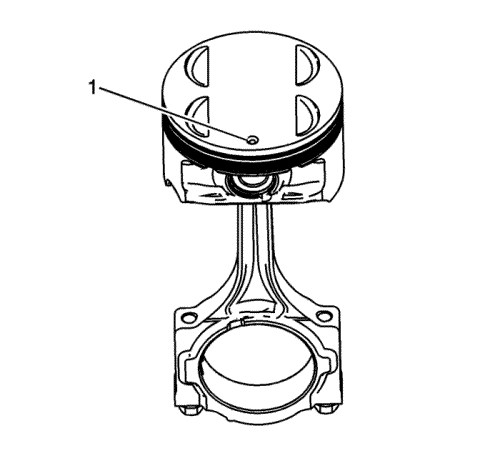
- Liberally lubricate the cylinder walls, piston rings and piston skirts with engine oil.
Note: The piston is directional and must be installed in the engine block in the proper direction. The dot on the top of the piston must face the front of the engine.
- Select the correctly numbered piston/connecting rod assembly for the cylinder. A dot (1) showing proper piston orientation is located on the top of the piston.
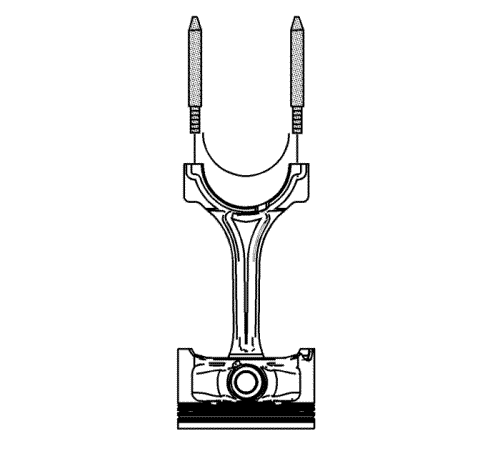
Note: If the connecting rod bearings have been used in a running engine, you must replace them with NEW connecting rod bearings for reassembly.
- Install the connecting rod bearing into the connecting rod.
- Install the EN 46121 pin set into the connecting rod bolt holes.
- Compress the piston rings using the EN 8037 compressor or equivalent.

Note: Extreme care must be used when installing the piston and connecting rod in order to be sure the rod does not scrape or nick the cylinder bore, the oil jets, or the crankshaft surfaces.
- Using both hands, slowly guide the piston and connecting rod assembly into the cylinder from the top and bottom of the cylinder. DO NOT allow the connecting rod to contact the cylinder wall.
- When the EN 8037 compressor contacts the deck surface, gently tap the piston into the cylinder using the handle end of a dead-blow hammer. Guide the connecting rod onto the crankshaft bearing journal using the EN 46121 pin set while gently tapping the piston into the cylinder with a soft-blow hammer.

- Remove the EN 46121 pin set from the connecting rod bolt holes.
Connecting Rod Bearing Clearance Measurement Procedure - Using Plastic Gaging
Note: Connecting rod bearings that have been run in an engine should NEVER be reused.
Before final assembly it is important to check the clearance of the new connecting rod bearings.
- Place a length of fresh, room temperature plastic gaging material all the way across the connecting rod bearing journal.
- Install the connecting rod bearing into the connecting rod cap.
Note: The connecting rod is non-directional therefore the connecting rod bearing lock tangs can face inboard or outboard.
- Install the connecting rod end cap on its original connecting rod and ensure the bearing lock tangs are aligned on the same side of the rod.
Caution: Refer to Fastener Caution in the Preface section.
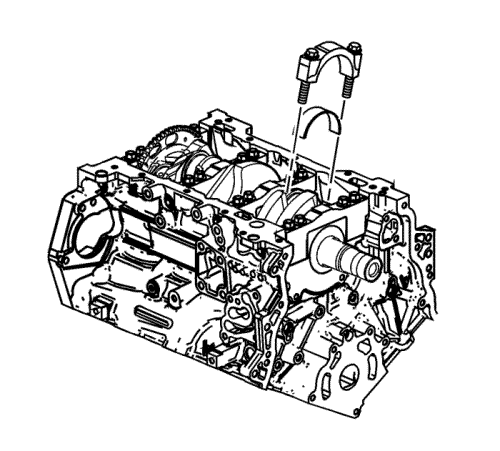
Caution: Do not lubricate the NEW connecting rod bolts. The NEW bolts have a pre-applied graphite lubricant. Applying lubricant to the connecting rod bolts will effect the clamp load when the connecting rod bolts are torqued. Improper clamp load can lead to component failure and extensive engine damage.
Note: Reuse the old connecting rod bolts ONLY for measuring the connecting rod bearing clearance.
- Install the connecting rod bolts into the connecting rod cap and tighten the connecting rod bolts to 30 N·m (22 lb ft).
- Loosen the connecting rod bolts until the torque reading is zero.
- Re-tighten the connecting rod bolts.
Tighten the connecting rod bolts to 25 N·m (18 lb ft).
Tighten the connecting rod bolts an additional 110 degrees using the EN 45059 meter .
- Allow the assembly to sit for at least 2 minutes.
- Remove the connecting rod cap bolts.
- Remove the connecting rod cap.
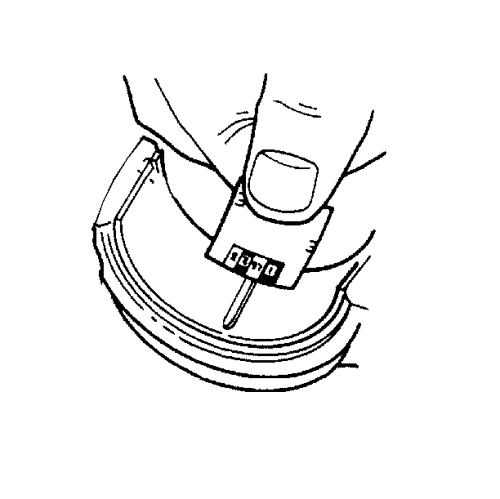
- Determine the connecting rod bearing clearance by comparing the width of the flattened plastic gaging material at its widest point with the graduation on the gaging material container.
- Compare your measurements with the engine mechanical specifications. If the new bearings do not provide the proper crankshaft to connecting rod bearing clearance, inspect the following:
| 11.1. | Re-measure the crankshaft connecting rod journals for the correct specified size and ensure the proper new bearings are being installed. If the crankshaft connecting rod journals are incorrectly sized, replace or regrind the crankshaft. Crankshaft machining is permitted and undersized bearings are available. |
| 11.2. | Re-measure the connecting rod bearing bore diameter to ensure proper size. The connecting rod is not machinable and the connecting rod must be replaced if out of specification. |
- Clean the plastic gaging material from the connecting rod bearing journals using a soft lint-free cloth.
Connecting Rod Bearing Clearance Measurement Procedure - Using EN 43690-A
The EN 43690-A checking tool has been developed as a more accurate method to measure connecting rod bearing clearances. The instructions below provide an overview of tool set-up and usage. For more detailed information, refer to the tool instruction sheets as supplied by the tool manufacturer.

EN 43690-A checking tool
| • | EN 43690-20 Swivel Base (1) |
| • | EN 43690-19 Dial Indicator (2) |
| • | EN 43690-5, -6 Handle (4) |
| • | EN 43690-10, -11 Foot (5) |
| • | EN 43690-1 Pivot Arm Assembly (7) |
| • | EN 43690-3, -7, -8 Screws (8) |
| • | EN 43690-17, -18 Adapter (11) |

EN 43690-A adapter kit
| • | EN 43690-104 Spacer (1) |
| • | EN 43690-105 Retainer Plate (2) |
| • | EN 43690-106 Retainer Plate (5) |
| • | EN 43690-101 Pivot Arm Assembly (8) |
| • | EN 43690-103 Adapter (9) |

Note: Connecting rod bearings that have been run in an engine should NEVER be reused.
Before final assembly it is important to check the clearance of the new connecting rod bearings.
- Install the connecting rod bearing into the connecting rod cap.
Note: The connecting rod is non-directional therefore the connecting rod bearing lock tangs can face inboard or outboard.
- Install the connecting rod end cap on its original connecting rod and ensure the bearing lock tangs are aligned on the same side of the rod.
Caution: Refer to Fastener Caution in the Preface section.
Caution: Do not lubricate the NEW connecting rod bolts. The NEW bolts have a pre-applied graphite lubricant. Applying lubricant to the connecting rod bolts will effect the clamp load when the connecting rod bolts are torqued. Improper clamp load can lead to component failure and extensive engine damage.
Note: Reuse the old connecting rod bolts ONLY for measuring the connecting rod bearing clearance.
- Install the connecting rod bolts into the connecting rod cap and tighten the connecting rod bolts to 30 N·m (22 lb ft).
- Loosen the connecting rod bolts until the torque reading is zero.
- Re-tighten the connecting rod bolts.
Tighten the connecting rod bolts to 25 N·m (18 lb ft).
Tighten the connecting rod bolts an additional 110 degrees using the EN 45059 meter .
- Rotate the crankshaft until the crankshaft journal and the connecting rod to be measured is in the 12 o'clock position.
Note: The crankshaft must be secure with no movement or rotation in order to obtain an accurate reading.
- Remove the crankshaft main bolts required to install the retainer plate EN 43690-105.
Note: Do not allow the EN 43690-105 retainer plate screw to contact the reluctor ring.
- Install the EN 43690-105 and crankshaft main bolts.
- Loosen the connecting rod bolts until the torque reading is zero.
- Re-tighten the connecting rod bolts.
Tighten the connecting rod bolts to 25 N·m (18 lb ft).
Tighten the connecting rod bolts an additional 110 degrees using the EN 45059 meter .
- During and after installation, ensure each piston is positioned properly in the correct cylinder. The locating arrow on the top of each piston must be pointing toward the front of the engine.
- Repeat these procedures for the remaining piston/connecting rod assemblies using the EN-48589 socket in order to rotate the crankshaft.
Connecting Rod Final Assembly Procedure
- Guide the connecting rod away from the crankshaft connecting rod journal in order to lubricate the crankshaft connecting rod bearing journal.
- Apply a liberal amount of crankshaft prelube or clean engine oil to the crankshaft connecting rod bearing journal. Refer to Adhesives, Fluids, Lubricants, and Sealers for recommended lubricant.
- Guide the connecting rod to the crankshaft connecting rod journal.
- Install the connecting rod end cap on its original connecting rod and ensure the bearing lock tangs are aligned on the same side of the rod.
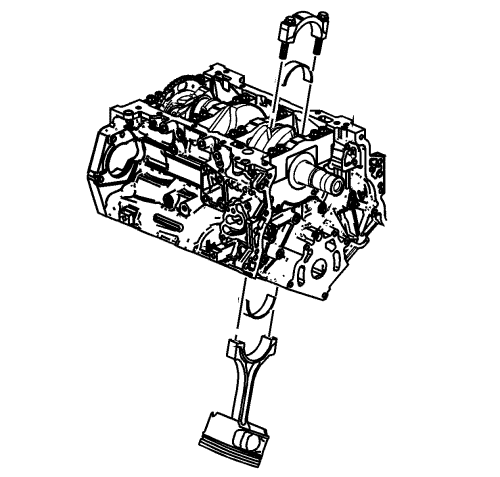
Caution: Do not lubricate the NEW connecting rod bolts. The NEW bolts have a pre-applied graphite lubricant. Applying lubricant to the connecting rod bolts will effect the clamp load when the connecting rod bolts are torqued. Improper clamp load can lead to component failure and extensive engine damage.
Note: DO NOT reuse the old connecting rod bolts.
- Install the NEW connecting rod bolts into the connecting rod cap and tighten the NEW connecting rod bolts to 30 N·m (22 lb ft).
- Loosen the connecting rod bolts until the torque reading is zero.
- Re-tighten the connecting rod bolts.
Tighten the connecting rod bolts to 25 N·m (18 lb ft).
Tighten the connecting rod bolts an additional 110 degrees using the EN 45059 meter .
- During and after installation, ensure each piston is positioned properly in the correct cylinder. The locating arrow on the top of each piston must be pointing toward the front of the engine.
- Repeat these procedures for the remaining piston/connecting rod assemblies using the EN 45059 meter in order to rotate the crankshaft.
| © Copyright Chevrolet. All rights reserved |









